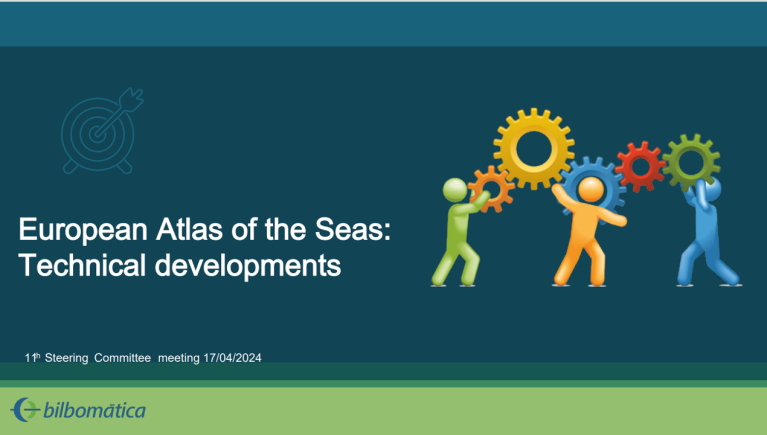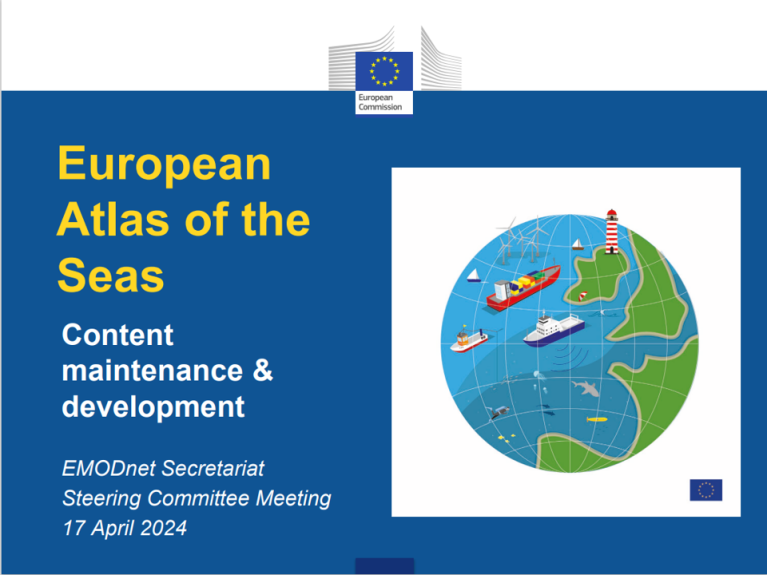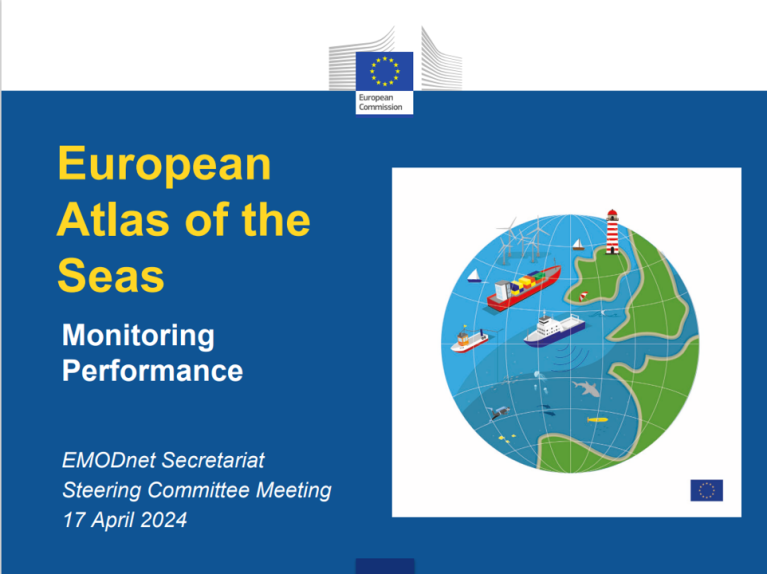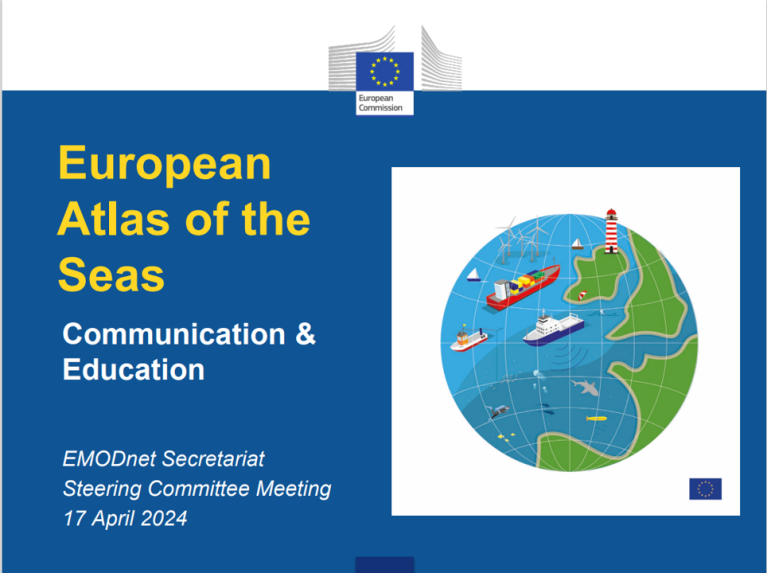Meeting location: Remote meeting with Zoom
Date and time: 17 April 2024, 10:30 to 12:00 CEST
List of actions
|
SC # |
Action |
Description |
Who? |
Status |
|---|---|---|---|---|
|
11 |
1 |
Update older map layers where updates are available |
EMODnet Secretariat and Bilbomática |
Ongoing |
|
11 |
2 |
Move the date of the data from the legend to the information box where it is more relevant. |
EMODnet Secretariat and Bilbomática |
To do |
|
11 |
3 |
Work with the EEA for the description of new map layers based on EEA data. |
EMODnet Secretariat and Bilbomática |
To do |
|
11 |
4 |
Further strengthen and develop cooperation with ocean literacy and education networks for promotion of the Atlas |
EMODnet Secretariat |
Ongoing |
Meeting Minutes
-
Welcome and Introduction - 15’
Conor Delaney (EMODnet Secretariat) opened the meeting and presented the agenda. The aim of the meeting was to present the latest developments of the European Atlas of the Seas and the next steps and gather feedback from the Steering Committee members.
Tour de table – 7’
Participants in the meeting (see Annex 1) presented themselves and their role related to the European Atlas of the Seas.
Perspectives from DG MARE – 5’
Chantal Vanhove (DG MARE) explained that the Atlas team concentrates on three pillars that include development, content and communication. A lot has been achieved with the available resources.
Approval of the agenda – 3’
The agenda was approved with no additional comments.
-
Development of the Atlas – 20’
Achieved and ongoing technical developments – 5’
Clara Becares (Bilbomática) presented the technical developments (see presentation below). Achieved developments include preparatory work on the My Maps V2 functionality, work carried out on translations of updated maps and maintenance.

Atlas traffic in 2023 was analysed and a performance test of the SQLite database solution was performed for different database sizes and number of concurrent requests. In addition, a performance test of the SpatialLite SQLite spatial component (required for the My Maps Version 2 features) was performed. In this test, SQLite demonstrated a good performance for the My Maps Version 2. As such, this database solution will be maintained for the further development of the My Maps tool.
A page with the accessibility statement was added to the Atlas and is available in the 24 languages.
Planned features – 10’
Planned features include the implementation of My Maps version 2, the mobile version of the Atlas and the monitoring tool. It will be necessary to decide on the priorities.
My Maps version 2 will include two tools that will allow teachers to customise and create their own maps in the Atlas. "My locations" will allow users to add locations and associated information to the map directly in the Atlas or by copying information from a table. My Notes will allow users to annotate maps with markers, lines and polygons as well as text labels. Next steps in the implementation is the update of the SQLite database (with a version upgrade, SpatialLite integration, and update of the data model to accommodate the new features) and an update of the My Maps API to handle the new database operations.
Steering Committee Feedback - 5’
Following a question from Conor Delaney (EMODnet Secretariat), Clara Becares explained that it is not expected to have very complex geometry in "My Notes" tool as geometries need to be manually drawn in the Atlas with the purpose of annotating maps.
-
Content maintenance and development - 20’
Achieved and ongoing content development – 5’
Tim Collart (EMODnet Secretariat) presented the content development (see presentation below). Content is the center piece of the Atlas and the reason people use the Atlas.

Since the last Steering Committee meeting, three map layers have been added and 48 map layers have been updated. The focus has been on updating maps layers.
Added map layers include:
- the map that resulted from the Education for Climate challenge;
- European Maritime Day in my country 2023;
- European Maritime Day in my country 2024.
The list of updated maps is included in the presentation. Work has been done with EMODnet Physics following the transition to the new infrastructure. The Mission Actions map layer is updated on a monthly basis. Maps from the three EU4Ocean Coalition communities are also updated.
Some map layers cannot be updated (e.g. ended projects). In some cases, the data is still valid. These map layers are thus kept within the Atlas. In other cases, outdated maps without available updates could be removed and replaced by other datasets on the same topic.
Five new predefined maps on topics related to the pillars of the EU Green Deal have been added.
The Atlas community and the Teachers Corner on the Maritime Forum have been migrated in the new Europa Web Publishing Platform (EWPP). The website structure has been rebuilt, making it easier for users to find relevant content for them.
The Atlas feedback form has been replaced by a feedback form on the Maritime Forum.
The Atlas team is working to make the date of the data in the map layers more visible.
The Atlas team is also working to make it easier for users to link to websites where they can find the datasets used to create the map layers. The approach to make this possible varies with data providers.
Proposal for existing content revision – 5’
A comprehensive review of available map layers is ongoing. The results of the analysis are included in the presentation included above. A prioritisation mechanism will be applied in updating map layers. This will be based on how old the map layers are and traffic to these map layers.
Proposal for new content – 5’
The list of new proposed map layers is included in the presentation included above. The Atlas team is in contact with data providers and projects.
New predefined maps will also be added. Translations are pending. Existing map layers that include too many layers will be simplified.
New map stories, based on Maps of the Week, will be translated and added to the Atlas.
Steering Committee Feedback – 5’
Conor Delaney asked if the Atlas team is using the new Copernicus data store. Tim Collart explained that the team uses the Web Map Tile Service (WMTS) provided by the new Copernicus infrastructure.
Julien Gaffuri (Eurostat) mentioned that updating map layers based on Eurostat is a priority. Map layers on employment are the oldest maps that need to be updated. He looked for the reference year for data in the information box of map layers but it is usually in the legend. He suggested moving the information on the data from the legend to the information box. He agreed that some predefined maps currently include too many layers. The information is too clustered when users zoom out. For teachers, it is important to focus on simple information at all scales. He detected some improvements that could be implemented on how symbols appear on the map layers.
Tim Collart explained that the Atlas team always makes the individual map layers intuitive to interpret. In some cases, when web services are used, the team cannot control how the maps are styled. It is therefore not always possible to combine maps layers and keep the oversight. We are planning a revision of which map layers are combined in the predefined maps so that they are less information dense.
Fanny Gard (DG ENV) asked if there is a map layer on the digital revolution. Tim Collart explained this is not the case. She asked how the Atlas team wants to work with the European Environment Agency (EEA). Tim Collart answered that the team will look into the EEA catalogue to see what can be published. Existing map services will be used. The Atlas team will add a description of the map layers and ensure that the descriptions are not too technical. It will thus be useful to work on these descriptions with the EEA.
Fanny Gard asked if the Atlas team wishes to expand the audience beyond teachers. Tim Collart explained that the audience for the Atlas is very diverse and referred to the presentation on communication activities related to the Atlas (see point 5 below).
Zoi Konstantinou (DG MARE) pointed out that EMODnet focuses on data distribution while the European Atlas of the Seas focuses on ocean literacy.
-
Monitoring performance – 10’
Web traffic analysis and trends – 5’
Tim Collart presented the results of web monitoring (see presentation below).

The Atlas team observes a growing trend every year. A dip in traffic is usually observed during the holidays. Traffic peaks coincide with online promotion of the Atlas, either by the Atlas team or by third parties that embed the Atlas in their web page. There is no direct impact from physical events apparent in the web traffic though they are important to build the network of the Atlas and the long term growth in traffic. The languages in which the Atlas is used are gradually becoming more diverse since the introduction of translations, indicating the Atlas is reaching a wider audience from across Europe and beyond. Users reach the Atlas in various ways, including from the EMODnet website where the Maps of the Week are published (35% of users), Google, direct entries and third parties including learning communities (e.g. the European Commission’s Learning Corner).
Top map layers visited include the ferry routes, wind farms, country borders, rivers and lakes and Mission actions.
Comments and questions received via the feedback form are analysed and addressed by the Atlas team.
Steering Committee Feedback - 5’
Carlos Cerezo (DG MARE) asked the time frame for the monitoring data shown. Tim Collart explained that the monitoring data covers the period from 24 April 2023 to 14 April 2024.
-
Promotion, Events and Partnerships - 20’
Achieved and ongoing promotion – 5’
Nathalie Van Isacker (EMODnet Secretariat) pointed out that communication activities are organised to reach out to the diverse audience of the Atlas. While the focus is on teachers and schools, many other users are interested in the Atlas. Activities are organised accordingly.
The Atlas is promoted through both offline and online communication activities that strengthen each other (see presentation below).

Cooperation and synergies with ocean literacy and education networks (e.g. EU4Ocean, European Schoolnet) are very important. They provide a multiplier effect and make it possible to promote the Atlas across Europe.
In 2024, the Atlas team has been building on the activities carried out in 2023 and implementing new activities.
Activities implemented in 2023 continue to provide impact. For example, the article published in the Science in Schools journal in English is now available also in Spanish and Greek.
Following the successful workshops for pupils at De Plataan primary school in Belgium in 2023, the Atlas team was again invited to organise workshops for pupils in the 5th year. These workshops provide important insight. It is interesting to see how young users interact with the Atlas. The workshop confirmed that the Atlas is intuitive and children can learn to use it autonomously in a short time. As the ocean is not included in the curriculum, teachers who wish to teach about the ocean bring the ocean into the classroom through other topics that are included in the curriculum (e.g. pollution). Such workshops are useful to get feedback to improve the content and features. Based on this experience, the Atlas team aims to give teachers the tools to create their own workshops in the future.
Nathalie Van Isacker highlighted three events where the Atlas was promoted in the past months (see presentation above).
-
- Promotion of the Atlas at the Ocean Literacy in Action conference on 8 March 2024 allowed to discuss the Atlas directly with existing users as well as potential new users.
- Contribution to the online EU4OCEAN SPOW on plastic pollution on 11 March 2024 allowed to reach out to teachers who were already using the Atlas as well as teachers who were discovering the Atlas.
- Promotion of the Atlas at the European Youth Week on 12 April 2024 on the combined Youth4Ocean Forum and Education for Climate Coalition stand was a great opportunity to talk to young people and share the story of the Education for Climate challenge and resulting map in the Atlas.
Other events mentioned included the VLIZ marine science day and the European Ocean Days.
In addition to the synergies developed with the EU4Ocean Coalition, the Atlas team is also connecting the Atlas and the OceanICU project.
Online activities include the publication of the Maps of the Week and inclusion of the Maps of the Month in the DG MARE newsletter. Communication is also carried out on X (previously Twitter) which now has over 2880 followers.
New content has been added to the Atlas’ Teachers Corner, including a new quiz on marine litter and the "Blue Economy Challenge" game associated with the 2024 EMD in my Country map layer.
Promotion plan – 10’
The promotion plan will focus on further strengthening and developing partnerships and cooperation with ocean literacy and education networks and projects.
Steering Committee Feedback – 5’
Participants in the meeting had no questions regarding communication activities.
-
Conclusions and forward look – 5’
DG MARE thanked the Atlas team for their ongoing commitment to improving and promoting the Atlas. All participants were thanked for their contributions to the Steering Committee Meeting.
Annex 1 – List of participants
|
Name |
Organisation |
|---|---|
|
Zoi Konstantinou |
DG MARE |
|
Chantal Vanhove |
DG MARE |
|
Grigore Rischitor |
DG MARE |
|
Carlos Cerezo |
DG MARE |
|
Johanna Af Heurlin |
DG MARE |
|
Myra Bugeja |
DG MARE |
|
Fanny Gard |
DG ENV |
|
Julien Gaffuri |
EUROSTAT |
|
Alessandra Cacciari |
DG DEFIS |
|
Natalia Orio Moreno |
Bilbomática |
|
Clara Becares |
Bilbomática |
|
Kate Larkin |
EMODnet Secretariat |
|
Conor Delaney |
EMODnet Secretariat |
|
Tim Collart |
EMODnet Secretariat |
|
Nathalie Van Isacker |
EMODnet Secretariat |
